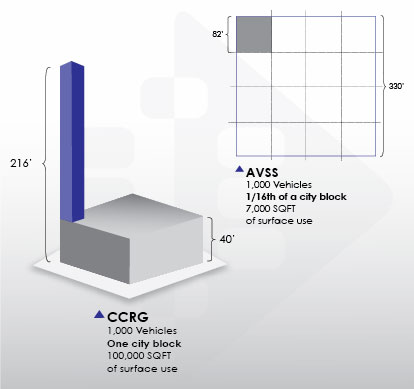Why AVSS
Maximizing function, reducing investment costs, helping the environment and improving quality of life.

We believe in a better quality of life through the use of state of the art and environmentally sensible technologies that promote social innovation.
We believe in a better quality of life through the use of state of the art and environmentally sensible technologies that promote social innovation.
The use of mechanical, automated and robotic vehicle storage systems is commonplace in Europe and Asia; in other markets however, is just beginning to bud, opening a wealth of opportunities for companies looking to provide investors and public and private clients with a reliable, sustainable and relevant solution that will change the concept of vehicle storage in urban and metropolitan areas.
Mechanical, Automated and Robotic Vehicle Storage Systems (known as AVSS) provide a substantial reduction in toxic emissions when compared to Conventional Concrete Ramp Garages (CCRGs); they also provide a quick and efficient way to park and retrieve vehicles minimizing city center congestion, air pollution and fuel consumption.
AVSS can deliver a commissioned project within 90 days and are designed to withstand seismic activity ensuring a safe and secure facility for vehicles and their users. A fully automated vehicle storage system is operational twenty-four hours a day without the need of staff.
Environmental impact
Studies performed by the EPA show that vehicle storage system with the equivalent capacity of a 500 car garage will save over 6,000 gallons of gasoline per year.
Minimal illumination requirements provide significant savings in energy consumption. The following systems may be implemented as a contingency in case of a power outage.
- Solar panel
- Battery Back-Up
- Back-Up diesel generator
AVSS employs interchangeable electromechanical motors, giving it a considerable advantage over competitive systems that run on hydraulics. Major drawbacks of hydraulic systems vis-à-vis electromechanical motors include:
- Greater heat generation
- Higher emissions of hazardous airborne oil particles
- Greater noise in operation
- High risk of component failure
AVS systems have been designed with special drip trays underneath each vehicle, capable of catching any damaging fluids that may fall from the vehicle stored directly above (such as coolant or oil based lubricants). This ensures that waste products are disposed of in an acceptable manner and protect the integrity of the vehicles stored below.
Transforming parking to protect the planet
See how automated Parking Systems reduce vehicle emissions.
Reduction of Carbon Dioxide - CO2
Reduction of Nitrogen Dioxide - NO2
Reduction of Carbon Monoxide - CO
Reduction of Volatile Organic Compounds - VOC
Eliminate:
Pounds
of Hydrocarbons
Tons
of Carbon Monoxide
Pounds
of Nitrogen Oxides
Tons
of Carbon Dioxide
(reduced land requirements and costs)

AVSS use a significantly smaller footprint than conventional vehicle storage solutions such as Conventional Concrete Ramp Garages - CCRG. Depending on configuration, less than 50% of land is required compared to a CCRG, thus significantly reducing the cost of real estate acquisition or maximizing usage and profitability of the available real estate. When space is at a premium, AVSS is the most cost-effective (and in some cases the only) solution to provide vehicle storage services in high density areas with high demand and limited offer and/or land availability.
A minimal footprint is achieved by eliminating:
- Walkways, fire exits, stairs, and elevator spaces
- Toll booth / ticketing space
- Internal Ramps
- Lost areas in turn-around bays & dead zones
- Corners where two spaces are 90° to each other
- Flexible stall heights and widths
This also has a direct relationship with underground parking where excavation requirements can be substantially reduced thus limiting the amount of soil to be removed and disposed. AVSS is 100% aligned and particularly relevant in areas where an “Infill Approach” is the most suitable (if not the only) answer. The infill approach is an urban planning concept and refers to the rededication of available land or to the construction of undeveloped land within the urban area. Infill also refers to land usage within a high density and built-up area, particularly for community redevelopment, growth management or smart growth projects. The Infill Approach aims to maximize the use of obsolete, wasted or underutilized buildings and sites within the urban area subject to development or revitalization.
- Lower land requirement
- Lower land cost
- Lower operational cost
- Lower insurance cost
- Lower energy cost
- Faster depreciation
- Faster construction period
- Higher salvage value - life cycle analysis
- Flexibility of use (for vehicle storage and other alternative uses)
- Rational use of funds: (TIF - mandatory value engineering)
- Lower crime related costs (www.bjs.gov NCVS)
- Increased safety for people & property
- Provides new opportunities for green spaces
- Traffic flow intelligence capabilities
- Improves quality of life
- Infill approach capabilities
- Better architectural design integration,
- Reduced visual pollution (not an eye sore)

